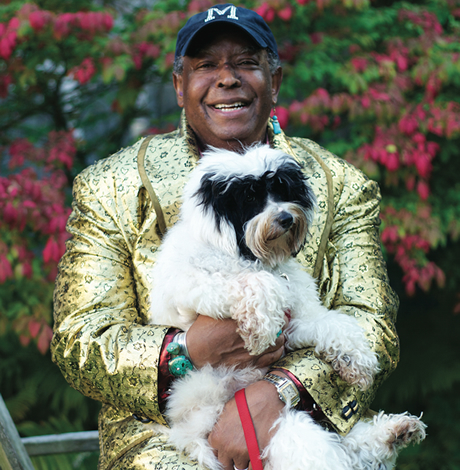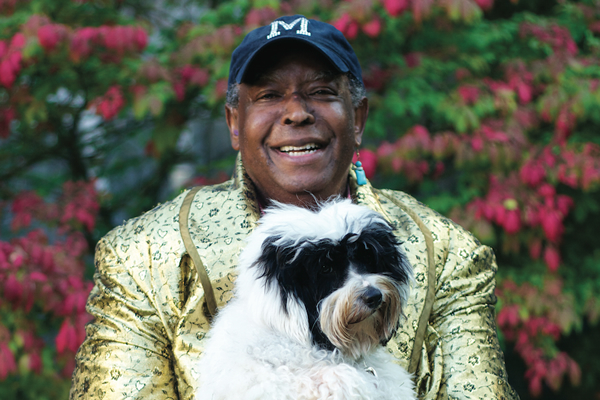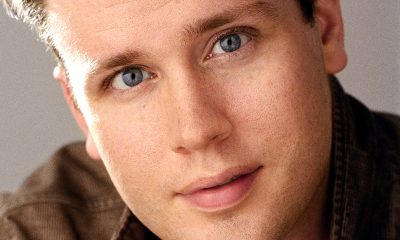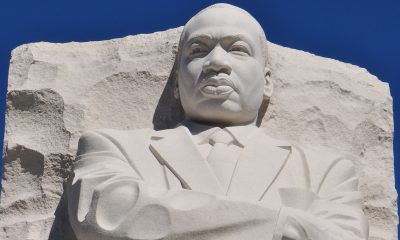Books
Gay Mister Rogers actor no longer bound by oath to children’s TV titan
François S. Clemmons shares abusive childhood, closeted career in new memoir


‘Officer Clemmons: A Memoir’
By François S. Clemmons
Catapult
May 5
$26
288 pages
In our polarized era, few people are loved by everyone from millennials to boomers. Yet, it’s a safe bet that even Darth Vader has a soft spot for Fred Rogers, creator and host of the children’s TV show “Mister Rogers’ Neighborhood,” which ran on PBS from 1968-2001. (Rogers died in 2003.)
François S. Clemmons, the black, gay opera singer and actor, played Officer Clemmons, one of the “neighbors” on the show. He was the first African-American to have a recurring role on a children’s TV show.
The moment in 1969 when Mister Rogers, a white man, invited Officer Clemmons, a black man, to dunk his feet in a wading pool with him is etched in our DNA. In the aftermath of the assassination of Martin Luther King, Jr., it was a quiet, but radical, stand against racism.
“Officer Clemmons: A Memoir,” released in early May, is Clemmons’ honest, engaging account of his life. In it, Clemmons reflects on his experience as an abused child, encounters with racism, struggle with his sexuality, professional success and friendship with Rogers. The book is filled with warmth and love — for Rogers, music, his friends, colleagues, family and children. Yet, Clemmons doesn’t sugar-coat the difficulties he’s endured or the hard truths he’s learned.
The memoir begins with a letter that Clemmons writes to Rogers years after his death. Over the decades, Clemmons writes, fans have asked him questions ranging from “How’d you meet him? to “How did you get out of the television?”
These questions were one reason Clemmons wrote the memoir. Yet, there was another compelling reason. He’d read bios of Rogers, but after reading these accounts, he writes, “I concluded that … none of the other publications were authored by a black, gay, ordained person of the theater who had worked intimately with you (Rogers) for over 30 years.”
His friendship with Roger and his work with the “Neighborhood” were vitally important to him. Yet Clemmons’ life has encompassed far more than being a “neighbor.” Born in 1945 in Blackwater, Miss., he earned a degree in music from Oberlin College and a master’s from Carnegie Mellon University. Clemmons won a Grammy Award for his recording of “Porgy and Bess” and founded the Harlem Spiritual Ensemble. From 1997-2013, he was the Alexander Twilight artist in residence and director of the Martin Luther King Spiritual Choir at Middlebury College.
As a child in a racist Southern town, Clemmons watched as his father abused his mother.
“My dreams conjured up the dangerous kitchen knife that my mother used in her fight against my daddy,” Clemmons writes.
To get away from her abusive husband, Clemmons’ mother moved the family to Youngstown, Ohio. Because he was black, his high school guidance counselors discouraged him from applying to Oberlin.
“I learned about racial segregation well above the Mason-Dixon Line,” he writes.
In Youngstown, his mother remarried. His stepfather abused Clemmons. Clemmons realized he was gay.
“My family was a traditional Baptist, God-fearing one,” Clemmons writes, “And even before I understood what homosexuality meant, it was drilled into my brain that these (gay) men were wrong in the eyes of God.”
At Oberlin, Clemmons embraced his sexuality forming friendships and relationships with queer men both out and closeted. With his school choir, he sang in the Soviet Union. He was inspired when he met Martin Luther King Jr. when King spoke at Oberlin.
Rogers met Clemmons when he heard him sing at a church. Clemmons began appearing on Rogers’ show when he was a grad student at Carnegie Mellon. Rogers loved Clemmons as a friend and respected his talent. Yet, he was a product of his time. “If you’re gay, it doesn’t matter to me at all,” Rogers told Clemmons, “but if you’re going to be on the show … you can’t be out as gay.”
Clemmons stayed in the closet so he could continue to work with Rogers. He tried hetero marriage (it didn’t work out). Despite having to hide his sexuality, Clemmons treasured his friendship with Rogers, his spiritual father and mentor.
If you’re looking for hope, inspiration and grit, “Officer Clemmons: A Memoir” is the book for you.
Books
New book offers observations on race, beauty, love
‘How to Live Free in a Dangerous World’ is a journey of discovery

‘How to Live Free in a Dangerous World: A Decolonial Memoir’
By Shayla Lawson
c.2024, Tiny Reparations Books
$29/320 pages
Do you really need three pairs of shoes?
The answer is probably yes: you can’t dance in hikers, you can’t shop in stilettos, you can’t hike in clogs. So what else do you overpack on this long-awaited trip? Extra shorts, extra tees, you can’t have enough things to wear. And in the new book “How to Live Free in a Dangerous World” by Shayla Lawson, you’ll need to bring your curiosity.

Minneapolis has always been one of their favorite cities, perhaps because Shayla Lawson was at one of Prince’s first concerts. They weren’t born yet; they were there in their mother’s womb and it was the first of many concerts.
In all their travels, Lawson has noticed that “being a Black American” has its benefits. People in other countries seem to hold Black Americans in higher esteem than do people in America. Still, there’s racism – for instance, their husband’s family celebrates Christmas in blackface.
Yes, Lawson was married to a Dutch man they met in Harlem. “Not Haarlem,” Lawson is quick to point out, and after the wedding, they became a housewife, learned the language of their husband, and fell in love with his grandmother. Alas, he cheated on them and the marriage didn’t last. He gave them a dog, which loved them more than the man ever did.
They’ve been to Spain, and saw a tagline in which a dark-skinned Earth Mother was created. Said Lawson, “I find it ironic, to be ordained a deity when it’s been a … journey to be treated like a person.”
They’ve fallen in love with “middle-American drag: it’s the glitteriest because our mothers are the prettiest.” They changed their pronouns after a struggle “to define my identity,” pointing out that in many languages, pronouns are “genderless.” They looked upon Frida Kahlo in Mexico, and thought about their own disability. And they wish you a good trip, wherever you’re going.
“No matter where you are,” says Lawson, “may you always be certain who you are. And when you are, get everything you deserve.”
Crack open the front cover of “How to Live Free in a Dangerous World” and you might wonder what the heck you just got yourself into. The first chapter is artsy, painted with watercolors, and difficult to peg. Stick around, though. It gets better.
Past that opening, author Shayna Lawson takes readers on a not-so-little trip, both world-wide and with observant eyes – although it seems, at times, that the former is secondary to that which Lawson sees. Readers won’t mind that so much; the observations on race, beauty, love, the attitudes of others toward America, and finding one’s best life are really what takes the wheel in this memoir anyhow. Reading this book, therefore, is not so much a vacation as it is a journey of discovery and joy.
Just be willing to keep reading, that’s all you need to know to get the most out of this book. Stick around and “How to Live Free in a Dangerous World” is what to pack.
The Blade may receive commissions from qualifying purchases made via this post.
Books
Story of paralysis and survival features queer characters
‘Unswerving: A Novel’ opens your eyes and makes you think

‘Unswerving: A Novel’
By Barbara Ridley
c.2024, University of Wisconsin Press
$19.95 / 227 pages
It happened in a heartbeat.
A split-second, a half a breath, that’s all it took. It was so quick, so sharp-edged that you can almost draw a line between before and after, between then and now. Will anything ever be the same again? Perhaps, but maybe not. As in the new book “Unswerving” by Barbara Ridley, things change, and so might you.

She could remember lines, hypnotizing yellow ones spaced on a road, and her partner, Les, asleep in the seat beside her. It was all so hazy. Everything Tave Greenwich could recall before she woke up in a hospital bed felt like a dream.
It was as though she’d lost a month of her life.
“Life,” if you even wanted to call it that, which she didn’t. Tave’s hands resembled claws bent at the wrist. Before the accident, she was a talented softball catcher but now she could barely get her arms to raise above her shoulders. She could hear her stomach gurgle, but she couldn’t feel it. Paralyzed from the chest down, Tave had to have help with even the most basic care.
She was told that she could learn some skills again, if she worked hard. She was told that she’d leave rehab some day soon. What nobody told her was how Les, Leslie, her partner, girlfriend, love, was doing after the accident.
Physical therapist Beth Farringdon was reminded time and again not to get over-involved with her patients, but she saw something in Tave that she couldn’t ignore. Beth was on the board of directors of a group that sponsored sporting events for disabled athletes; she knew people who could serve as role models for Tave, and she knew that all this could ease Tave’s adjustment into her new life. It was probably not entirely in her job description, but Beth couldn’t stop thinking of ways to help Tave who, at 23, was practically a baby.
She could, for instance, take Tave on outings or help find Les – even though it made Beth’s own girlfriend, Katy, jealous.
So, here’s a little something to know before you start reading “Unswerving”: author Barbara Ridley is a former nurse-practitioner who used to care for patients with spinal cord injuries. That should give readers a comfortable sense of satisfaction, knowing that her experiences give this novel an authenticity that feels right and rings true, no faking.
But that’s not the only appeal of this book: while there are a few minor things that might have readers shaking their heads (HIPAA, anyone?), Ridley’s characters are mostly lifelike and mostly likable. Even the nasties are well done and the mysterious character that’s there-not-there boosts the appeal. Put everyone together, twist a little bit to the left, give them some plotlines that can’t ruined by early guessing, and you’ve got a quick-read novel that you can enjoy and feel good about sharing.
And share you will because this is a book that may also open a few eyes and make readers think. Start “Unswerving” and you’ll (heart) it.
The Blade may receive commissions from qualifying purchases made via this post.
Books
Examining importance of queer places in history of arts and culture
‘Nothing Ever Just Disappears’ shines with grace and lyrical prose

‘Nothing Ever Just Disappears: Seven Hidden Queer Histories’
By Diarmuid Hester
c.2024, Pegasus Books
$29.95/358 pages
Go to your spot.
Where that is comes to mind immediately: a palatial home with soaring windows, or a humble cabin in a glen, a ramshackle treehouse, a window seat, a coffeehouse table, or just a bed with a special blanket. It’s the place where your mind unspools and creativity surges, where you relax, process, and think. It’s the spot where, as in the new book “Nothing Ever Just Disappears” by Diarmuid Hester, you belong.

Clinging “to a spit of land on the south-east coast of England” is Prospect Cottage, where artist and filmmaker Derek Jarman lived until he died of AIDS in 1994. It’s a simple four-room place, but it was important to him. Not long ago, Hester visited Prospect Cottage to “examine the importance of queer places in the history of arts and culture.”
So many “queer spaces” are disappearing. Still, we can talk about those that aren’t.
In his classic book, “Maurice,” writer E.M. Forster imagined the lives of two men who loved one another but could never be together, and their romantic meeting near a second-floor window. The novel, when finished, “proved too radical even for Forster himself.” He didn’t “allow” its publication until after he was dead.
“Patriarchal power,” says Hester, largely controlled who was able to occupy certain spots in London at the turn of the last century. Still, “queer suffragettes” there managed to leave their mark: women like Vera Holme, chauffeur to suffragette leader Emmeline Pankhurst; writer Virginia Woolf; newspaperwoman Edith Craig, and others who “made enormous contributions to the cause.”
Josephine Baker grew up in poverty, learning to dance to keep warm, but she had Paris, the city that “made her into a star.” Artist and “transgender icon” Claude Cahun loved Jersey, the place where she worked to “show just how much gender is masquerade.” Writer James Baldwin felt most at home in a small town in France. B-filmmaker Jack Smith embraced New York – and vice versa. And on a personal journey, Hester mourns his friend, artist Kevin Killian, who lived and died in his beloved San Francisco.
Juxtaposing place and person, “Nothing Ever Just Disappears” features an interesting way of presenting the idea that both are intertwined deeper than it may seem at first glance. The point is made with grace and lyrical prose, in a storyteller’s manner that offers back story and history as author Diarmuid Hester bemoans the loss of “queer spaces.” This is really a lovely, meaningful book – though readers may argue the points made as they pass through the places included here. Landscapes change with history all the time; don’t modern “queer spaces” count?
That’s a fair question to ask, one that could bring these “hidden” histories full-circle: We often preserve important monuments from history. In memorializing the actions of the queer artists who’ve worked for the future, the places that inspired them are worth enshrining, too.
Reading this book may be the most relaxing, soothing thing you’ll do this month. Try “Nothing Ever Just Disappears” because it really hits the spot.
The Blade may receive commissions from qualifying purchases made via this post.
-

 Africa3 days ago
Africa3 days agoCongolese lawmaker introduces anti-homosexuality bill
-

 Colorado5 days ago
Colorado5 days agoFive transgender, nonbinary ICE detainees allege mistreatment at Colo. detention center
-

 World3 days ago
World3 days agoOut in the World: LGBTQ news from Europe and Asia
-

 Real Estate4 days ago
Real Estate4 days agoBoosting your rental property’s curb appeal












